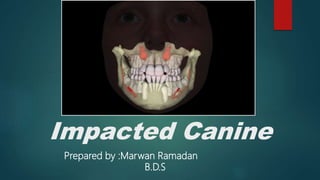L'impactation des canines maxillaires est fréquente, affectant environ 12 % à 15 % de la population, avec une prévalence doublée chez les femmes par rapport aux hommes. Plusieurs classifications des canines impactées existent en fonction de leur localisation et de leur inclinaison, et divers traitements peuvent être envisagés selon l'âge du patient et d'autres facteurs cliniques. Les options de traitement incluent des approches interceptives, chirurgicales avec ou sans traction orthodontique, et des interventions telles que la transplantation autologue ou l'extraction.




















































